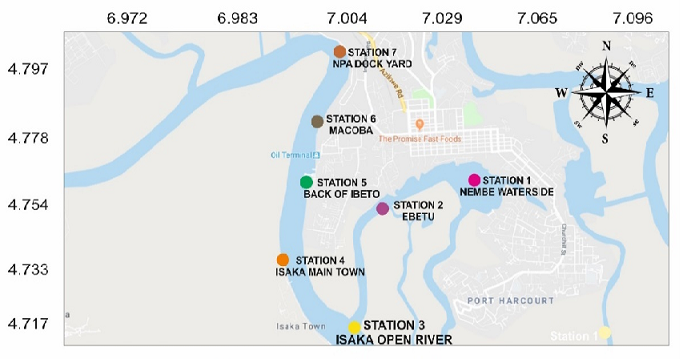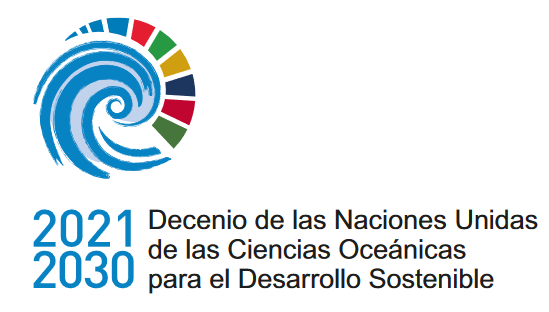Diversidad de floraciones de especies de algas nocivas en el área central del estuario del Río Bonny, delta del Níger, Nigeria
DOI:
https://doi.org/10.47193/mafis.3532022010908Palabras clave:
Distribución, estación, abundancia, HAS, gradientes ambientalesResumen
Este estudio se llevó a cabo entre diciembre de 2018 y noviembre de 2019 para examinar la distribución y abundancia de especies de algas nocivas (HAS, por sus siglas en inglés) en el área central del estuario del río Bonny. Se establecieron siete estaciones de muestreo con la herramienta ArcGIS. Las especies de microalgas se muestrearon con una red de plancton de 20 mm de malla. Los nutrientes se analizaron en laboratorio mediante el Método APHA 4500, mientras que las características fisicoquímicas se determinaron in situ. Los resultados revelaron que los gradientes ambientales fueron adecuados para sustentar la vida en esa parte del estuario, excepto por el fosfato (2,90 ± 0,22 - 9,48 ± 1,06 mg l-1). Se determinaron un total de 31 HAS categorizadas en 17 géneros y tres clases: Bacillariophyceae (29 especies), Chlorophyceae y Cyanophyceae (una especie cada una). Navicula amphibola tuvo la mayor densidad (4,713 x 103 células l-1) mientras que Pinnularia divergens registró la menor densidad (0,00049 x 103 células l-1). Los valores de densidad total disminuyeron a través de las estaciones con 9,157 x 103 células l-1 en la estación seca y 8,907 x 103 células l-1 en la estación húmeda. La lista de especies en las estaciones mostró que cinco especies se distribuyeron en las siete estaciones, mientras que dos se encontraron solo en las estaciones 2 y 7. Los índices de diversidad revelaron que el índice de Shannon osciló entre 3,17 y 3,25 y la uniformidad de las especies osciló entre 0,78 y 0,88, mientras que el valor del rango de Margalef (3,09-3,31) se consideró moderadamente estable. Por lo tanto, existe la necesidad de prácticas de gestión adecuadas que podrían ayudar a reducir el nivel de descarga de nutrientes en el área central del estuario del Bonny.
Descargas
Métricas
Citas
Abowei JFN, Ezekiel EN, Hansen U. 2012. Effects of water pollution on benthic macro fauna species composition in Koluama Area, Niger Delta Area, Nigeria. Intl J Fish Aquat Sci. 2 (1): 36-40.
Abubakar I. 2009. Limnological studies for the assessment of Sabke Lake Katsina State Nigeria [MSc thesis]. Zaria: Ahmadu Bello University. 75 p.
Adesalu TA, Nwankwo DI. 2008. Effect of water quality indices on phytoplankton of a Sluggish Tidal Creek in Lagos, Nigeria. J Biol Sci. 11 (6): 836-844.
Anderson DM, Gilbert PM, Burkholder JM. 2002. Harmful algal blooms and eutrophication: nutrient sources, composition and consequences. Estuaries. 25: 704-726. DOI: https://doi.org/10.1007/BF02804901
Anderson DM, Kulis DM, Doucette GJ, Gallagher JC, Balech E. 1994. Biogeography of toxic dinoflagellates in the genus Alexandrium from the north eastern United States and Canada. Mar Bio. 120: 467-478.
Ansa EJ. 2005. Studies of the benthic macro fauna of the Andoni flats in the Niger Delta Area of Nigeria [PhD thesis]. Port Harcourt: University of Port Harcourt. 242 p.
[APHA] American Public Health Association. 1998. Standard methods for the examination of water and wastewater. 20th ed. Washington (DC): American Public Health Association (APHA), American Water Works Association (AWWA) and Water Environmental Federation (WEF).
[APHA] American Public Health Association. 2012. Standard methods for the examination of water and wastewater. 22nd ed. Washington (DC): American Public Health Association (APHA), American Water Works Association (AWWA) and Water Environment Federation (WEF).
Asonye CC, Okolie NP, Okenwa EE, Iwuanyanwu UG. 2007. Some physical-chemical characteristics and heavy metal profiles of Nigerian rivers, streams and waterways. African J Biotech. 6 (5): 617-624.
Babu A, Varadharajan D, Vengadesh PN, Thilagavathi B, Manikandarajan T, Sampathkumar P, Balasubramanian T. 2013. Diversity of phytoplankton in different stations from Muthupettai, South East Coast of India. J Mar Sci Res Dev. 3: 128. DOI: http://dx.doi.org/10.4172/2155-9910.1000128
Badsi H, Ali HO, Loudiki M, Aamir A. 2012. Phytoplankton diversity and community composition along the salinity gradient of the mass Estuary. Am J Hum Ecol. 1 (2): 58-64.
Begon M, Harper JI, Townsend CR, editors. 1990. Ecology: individuals populations and communities. 2nd ed. Oxford: Blackwell Publishing. 759 p.
Boesch DF, Anderson DM, Horner RA, Shumway ES, Tester PA, Whitledge TE. 1997. Harmful algal blooms in coastal waters: options for prevention, control and mitigation. NOAA Coastal Ocean Program. Decision Analysis Series. 10
Boyd CE. 1981. Water quality in warmwater fishpond. 2nd ed. Alabama Craft Master.
Boyd CE, Lichtkoppler F. 1979. Water quality management in fishpond. Research and development. Series 22. Alabama: International centre for Aquaculture and Agriculture (ICAA), Experimental station Auburn University. p. 45-47.
Braide SA, Izonfuo WAL, Adiukwu PU, Chindah AC, Obunwo CC. 2004. Water quality of Miniweja stream. A swamp forest stream receiving non-point source waste discharges in Eastern Niger Delta, Nigeria. Sci Africana. 3 (1): 1-8.
Brand K, Larry E, Lisa C, Eileen B. 2012. The biology and ecology of a toxic genus. Harmful Algae. 14: 156-178.
Chindah AC, Braide SA. 2001. Crude oil spill and the phytoplankton community of a swamp forest stream. African J Environ Studies. 2 (1): 1-8.
Chindah AC, Nduaguibe U. 2003. Effect of tank farm wastewater on water quality and periphyton of Lower Bonny River Niger Delta, Nigeria. J Nig Env Soc. 1 (2): 206-222.
Clarke KR, Gorley RN. 2006. PRIMER v6: User Manual/Tutorial. PRIMER-E.
Clarke OE. 2005. The dynamics of plankton population in Ologe Lagoon, Lagos, Nigeria [PhD thesis]. Lagos State: Department of Zoology, Lagos State University. 343 p.
Dangana LB. 1985. Hydro geomorphological controls of the mangrove environment. In: Proceedings of a Workshop on the Mangrove Ecosystem of the Niger Delta. University of Port Harcourt. 357 p.
Davies OA. 2013. Seasonal variation of the physico-chemistry quality of a tributary of the Bonny estuary, Rivers State, Nigeria. J Advan Bio. 2 (1): 92-107.
Davies OA, Abowei JFN, Tawari CC. 2009. Phytoplankton community of Elechi Creek, Niger Delta, Nigeria: a nutrient polluted tropical creek. Am J Appl Sci. 6 (6): 1143-1152.
Davies OA, Ugwumba AAA, Abolude DS. 2008. Physico-chemistry quality of Trans- Amadi (Woji) creek, Port Harcourt, Niger Delta, Nigeria. J Fish Intl. 3 (3): 91-97.
Dibia AEN. 2006. Effect of biotope difference on aquatic Macrophytes along Mini-Chindah Stream in Port Harcourt, Rivers State [MSc thesis]. Port Harcourt: Rivers State University of Science and Technology. 120 p.
Dublin-Green CO. 1990. Seasonal variations in some physico-chemical parameters of the Bonny Estuary, Niger Delta. NIOMR Technical Paper. 59: 21-25.
Ebere N. 2002. The impact of oil refinery effluents on the distribution, abundance and community structure of macrobenthos in Okrika Creek [PhD thesis]. Port Harcourt: Department of Biological Sciences. Rivers State University of Science and Technology. 383 p.
Elliott JA. 2010. The seasonal sensitivity of Cyanobacteria and other phytoplankton to changes in flushing rate and water temperature. Glob Chang Biol. 16 (2): 864-876.
Erondu ES, Chinda AC. 1991. Variation in the physico-chemical features and phytoplankton of the New Calabar River, Aluu, Rivers State. Nigeria. Nigeria Institute of Marine and Oceanography Research. Technical Paper. 75: 1-18.
Giannuzzi L, Carvajal G, Corradini MG, Andrade CA, Echenique R, Andrinolo D. 2012. Occurrence of toxic cyanobacterial blooms in Rio de la Plata estuary, Argentina: field study and data analysis. J. Toxicol. 9 (373618): 1-15. DOI: https://doi.org/10.1155/2012/373618
Gilbert PM, Anderson DA, Gentien P, Granéli E, Sellner KG. 2005. The global, complex phenomena of harmful algal blooms. Oceanography. 18 (2): 136-147.
Glidewell C. 1990. The nitrate/nitrite controversy. Chemical Britanica. 26 (2): 137-140.
Hall NS, Paerl HW, Peierls BL, Whipple AC, Rossignol KC. 2013. Effects of climatic variability on phytoplankton community structure and bloom development in the eutrophic, microtidal, New River Estuary, North Carolina, USA. Estuar Coast Shelf Sci. 117: 70-82.
Hallegraeff GM, Anderson DM, Cembella AD. 1995. Manual on harmful marine microalgae. UNESCO. p. 1-22.
Hansen PJ. 2002. Effect of high pH on the growth and survival of marine phytoplankton: implications for species succession. Aquat Microb Ecol. 28: 279-288.
Indabawa II, Abdullahi BA. 2004. Ecology of fresh water phytoplankton of River Hadejia, Jigawa State. J Biol Environ Sci Tropics BUK. Nigeria. 2: 141-149.
Iqbal M, Kazmi A, Shoukat SA. 1990. Multivariate analysis of seasonal variation in zooplankton composition of Hub Lake. Pak J Zool. 22 (2):123-131.
[IOC] Intergovernmental Oceanographic Commission. 2015. Harmful Algal Bloom Programme. Oostende: UNESCO/IOC Project Office for IODE. [accessed 2022 March]. https://www.iode.org/index.php?option=com_oe&task=viewInstitutionRecord&institutionID=10171.
Jha BK, Mohan SS, Mol AA, Moses RMM. 2014. Diversity and ecology of phytoplankton in Manakudy estuary, Kanyakumari, Tamilnadu, India. Int J Pure Appl Zool. 2 (4): 308-314.
Kress N, Coto SL, Brenes CL, Brenner S, Arroyo G. 2002. Horizontal transport and seasonal distribution of nutrients, dissolved oxygen and chlorophyll a in the Gulf of Nicoya, Coasta Rica: a tropical estuary. Cont Shelf Res. 22: 51-56.
Larsson U, Elmgren R, Wulff F. 1985. Eutrophication and the Baltic Sea - causes and consequences. Ambio. 14: 9-14.
Margalef R. 1968. Perspectives in ecological theory. Illinois: University of Chicago Press. 111 p.
Marques SC, Azeiteiro UM, Martinho FY, Pardal MA. 2007. Climate variability and planktonic communities: the effect of an extreme event (severe drought) in a southern European estuary. Estuar Coast Shelf Sci. 73: 725-734.
Mokoginta MM. 2016. Tree species diversity at the protected forest of Mountain Masinggi, North Bolaang Mongondow, Indonesia. Intl J Agric. 6 (2): 69-73.
Nweke AN. 2000. Impact of organic wastes pollution on the macro-benthos and fish fauna of Elechi Creek [PhD thesis]. Port Harcourt: Department of Biological Sciences, Rivers State University of Science and Technology. 287 p.
Ofonmbuk O, Lawrence E. 2015. Phytoplankton of Stubbs Creek, Qua Iboe River Estuary, Nigeria. Am J Biol Life Sci. 3 (4): 132-140.
Ogamba EN, Chinda AC, Ekweozor IKE, Onwuteaka JN. 2004. Water quality and phytoplankton distribution in Elechi Creek Complex of the Niger Delta. J Niger Environ Soc. 1 (2): 121-130.
Ogbuagu DH, Ayoade AA. 2012. Phytoplankton Assemblage along Gradients of the Imo River in Etche Local Government Area, Nigeria. Ann Biol Res. 3 (4): 18-52.
Onwugbuta-Enyi J, Zabbey N, Erondu ES. 2008. Water quality of Bodo Creek in the lower Niger Delta basin. Adv Environ Biol. 2 (3): 132-136.
Onyema IC. 2008. A checklist of phytoplankton species of the Iyagbe lagoon, Lagos. J Fish Aquat Sci. 3 (3): 167-175.
Roelke DL, Errera RM, Kiesling R, Brooks BW, Grover JP, Schwierzke L, Urena Beck BW, Baker J, Pinckney JL. 2007. Effects of nutrient enrichment on Prymnesium parvum population dynamics and toxicity: results from field experiments, Lake Possum Kingdom, U.S.A. Aquat Microbiol Ecol. 46: 125-140.
Sellner KG, Doucette GJ, Kirkpatrick GJ. 2003. Harmful algal blooms: causes, impacts and detection. J Ind Microbiol Biotechnol. 30: 383-406.
Shannon CE, Wiener W. 1963. The mathematical theory of communication. Urbana: University of Illinois Press. 117 p.
Simpsons EH. 1949. Measurement of diversity. Nature. 163: 688.
Smayda TJ. 1998. Ecophysiology and bloom dynamics of Heterosigma akashiwo (Raphidophyceae). In: Anderson DM, Cembella AD, Hallegraeff GM, editors. Physiological ecology of harmful algal blooms. Vol. G41. NATO ASI Series. Berlin, Heidelberg: Springer-Verlag. p. 113-131.
Stirling G, Wilsey B. 2001. Empirical relationships between species richness, evenness, and proportional diversity. Amer Naturalist. 158: 286-299.
Sverdrup KA, Duxbury AC, Duxbury AB. 2003. Controls on primary production. An introduction to the Worlds Ocean. 7th ed. McGraw Hill.
Swann L. 2006. A fish farmer’s guide to understanding water quality in aquaculture. [accessed 2006 February 20]. http://www.aquanic.org.publicat/state/il-inas-503.htm.
Taylor FJR, editor. 1987. The biology of dinoflagellates. Oxford: Blackwell Scientific Publications. 785 p.
Tomas CR. 1997. Identifying marine phytoplankton. London: Academic Press. 858 p.
Uedema-Naa B, Gabriel UU, Akinrotimi OA. 2011. The relationship between aquatic macrophytes and water quality in Nta-Wogba stream, Port-Harcourt, Nigeria. J Fish Aquat Sci. 5 (2): 6-16.
Valsaraj KT, Thibodeaux LJ, Reible DD. 1995. Modeling air emissions from contaminated sediment dredged materials. In: Demars KR, Richardson GN, Yong RN, Chaney RC, editors. Dredging, remediation and containment of contaminated sediments, ASTM STP 1293. Philadelphia: American Society for Testing and Materials. p. 227-238.
Vincent-Akpu IF, Nwachukwu LC. 2016. Comparative Water Quality Assessment of Nembe, Bonny and Iwofe Ferry terminals in Port Harcourt, Nigeria. IOSR J Environ Sci Toxicol Food Technol. 10 (7): 15-19.
Wehr JD, Descy JP. 1998. Use of phytoplankton in large river management. J Phycol. 34: 741-749.
[WHO] World Health Organization. 2008. Guidelines for drinking-water quality. 3rd ed. Vol. 1. Recommendations. Geneva: WHO. 220 p.

Descargas
Publicado
Cómo citar
Número
Sección
Licencia
Derechos de autor 2022 Henry Dienye, Francis D. Sikoki, Geoffrey N. Woke, Olaniyi A. Olopade

Esta obra está bajo una licencia internacional Creative Commons Atribución-NoComercial-CompartirIgual 4.0.
Los autores de los artículos publicados en Marine and Fishery Sciences conservan los derechos de autor de sus artículos, a excepción de las imágenes de terceros y otros materiales añadidos por Marine and Fishery Sciences, que están sujetos a los derechos de autor de sus respectivos propietarios. Por lo tanto, los autores son libres de difundir y volver a publicar sus artículos, sujeto a los requisitos de los propietarios de derechos de autor de terceros y sujeto a que la publicación original sea completamente citada. Los visitantes también pueden descargar y reenviar artículos sujetos a los requisitos de citas. La capacidad de copiar, descargar, reenviar o distribuir cualquier material siempre está sujeta a los avisos de derechos de autor que se muestran. Los avisos de copyright deben mostrarse de manera prominente y no pueden borrarse, eliminarse u ocultarse, total o parcialmente. El autoalmacenamiento en servidores y repositorios de preimpresión está permitido para todas las versiones.
Esta revista ofrece a los autores una política de acceso abierto. Los usuarios pueden leer, descargar, copiar, distribuir, imprimir, buscar o vincular los textos completos de los artículos, o usarlos para cualquier otro propósito legal dentro de la licencia Creative Commons 4.0 (BY-NC-SA), sin solicitar permiso previo del editor o del autor. Esto está de acuerdo con la definición BOAI de acceso abierto.




























